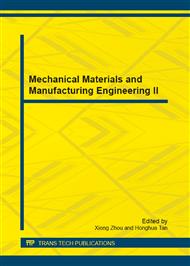[1]
W.S. Ngah, M.A.K.M. Hanafiah, Removal of heavy metal ions from wastewater by chemically modified plant wastes as adsorbents: A review. J. Bio. Tech. 99 (2008) 3935–3948.
DOI: 10.1016/j.biortech.2007.06.011
Google Scholar
[2]
K. Kadirvelu, K. Thamaraiselvi, C. Namasivayam, Removal of heavy metal from industrial wastewaters by adsorption onto activated carbon prepared from an agricultural solid waste. J. Bio. Techn. 76 (2001) 63–65.
DOI: 10.1016/s0960-8524(00)00072-9
Google Scholar
[3]
C. J Williams, D. Aderhold, G.J. Edyvean, Comparison between biosorbents for the removal of metal ions from aqueous solutions. J. Water Res. 32 (1998) 216–224.
DOI: 10.1016/s0043-1354(97)00179-6
Google Scholar
[4]
E. Demirbas, M. Kobya, M.T. Sulak, Adsorption kinetics of a basic dye from aqueous solutions onto apricot stone activated carbon. J. Bio. Tech. 99 (13) (2008) 5368–5373(2008).
DOI: 10.1016/j.biortech.2007.11.019
Google Scholar
[5]
T. Robinson, G. McMullan, R. Marchant, P. Nigam, Remediation of dyes in textile effluent: A critical review of on current treatment technologies with a proposed alternative. J. Bio. Tech. 77(3) (2001) 247-255.
DOI: 10.1016/s0960-8524(00)00080-8
Google Scholar
[6]
Z. Aksu, Application of biosorption for the removal of organic pollutants: a review. J. Pro. Biochem. 40 (2005) 997–1026.
Google Scholar
[7]
A. Dabrowski, Z. Hubicki, P. Podkościelny, E. Robens, Selective removal of the heavy metal ions from waters and industrial wastewaters by ion-exchange method. J. Chemosphere 56 (2(2004) 91-106.
DOI: 10.1016/j.chemosphere.2004.03.006
Google Scholar
[8]
M.A.K. H Hanafiah, S. Shafiei, M. K Harun, M.Z. A Yahya, Kinetic and thermodynamic study of Cd2+ adsorption onto rubber tree (Hevea brasiliensis) leaf powder. J. Mater. Sci. Forum 517 (2006) 217–221.
DOI: 10.4028/www.scientific.net/msf.517.217
Google Scholar
[9]
M.A.K. M Hanafiah, W.S. W Ngah, S. C Ibrahim, H. Zakaria, W.A.H.W. Ilias, Kinetics and thermodynamic study of lead adsorption onto rubber (Hevea brasiliensis) leaf powder. J. Appl. Sci. 6 (2006) 2762–2767.
DOI: 10.3923/jas.2006.2762.2767
Google Scholar
[10]
Karunasagar, D., Balarama Krishna, M.V., Rao, S.V. J. Arunachalam, Removal of preconcentration of inorganic and methyl mercury from aqueous media using a sorbent prepared from the plant Coriandrum sativum. J. Hazard. Matls. B 118 (2005) 133–139.
DOI: 10.1016/j.jhazmat.2004.10.021
Google Scholar
[11]
P. D Johnson, M. A Watson, J. Brown, I. A Jefcoat, Peanut hull pellets as a single use sorbent for the capture of Cu(II) from wastewater. J. Waste Manage. 22 (2002) 471–480.
DOI: 10.1016/s0956-053x(01)00036-8
Google Scholar
[12]
S. Y Quek, D.A. J Wase, C. F Forster, The use of sago waste for the sorption of lead and copper. J. Water SA 24 (1998) 251–256.
Google Scholar
[13]
M.F. Sawalha, J.R. Peralta-Videa, J. Romero-Gonza´lez, M. Duarte-Gardea, J.L. Gardea-Torresdey, Thermodynamic and isotherm studies of the biosorption of Cu(II), Pb(II), and Zn(II) by leaves of saltbush (Atriplex canescens). J. Chem. Thermodyn. 39 (2007).
DOI: 10.1016/j.jct.2006.07.020
Google Scholar
[14]
I. Gaballah, D. Goy, E. Allain, G. Kilbertus, J. Thauront, Recovery of copper through decontamination of synthetic solutions using modified barks. J. Met. Metall. Trans. B 28 (1997) 13–23.
DOI: 10.1007/s11663-997-0122-3
Google Scholar
[15]
A. Nakajima, T. Sakaguchi, Recovery and removal of uranium by using plant wastes. J. Biomass 21 (1990) 55–63.
DOI: 10.1016/0144-4565(90)90047-n
Google Scholar
[16]
J.M. Smith, Chemical Engineering Kinetics, 3rd ed. McGraw-Hill, New York (1981).
Google Scholar
[17]
A. A El-Hendawy, Influence of HNO3 oxidation on the structure and adsorptive properties of corncob-based activated carbon. Carbon 41 (4) (2003) 713-722.
DOI: 10.1016/s0008-6223(03)00029-0
Google Scholar
[18]
K. Bedoui, I, Bekri- Abbes, E. Srasra E, Removal of cadmium (II) from aqueous solution using pure smectite and Lewatite S 100: the effect of time and metal concentration. Desalination 223 (2008) 269–273.
DOI: 10.1016/j.desal.2007.02.078
Google Scholar
[19]
F. S Baker, C. E Miller, A. J Repik, E. D Tolles, Activated carbon, Encyl. Chem. Technol. 4 (1992) 1015-1037.
Google Scholar


